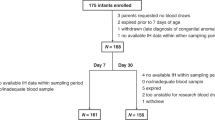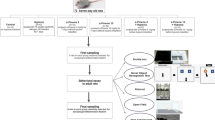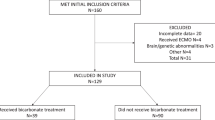Abstract
Summary: The possibility of detecting past hypoxia during the first 2 h after birth by means of blood analyses of hypoxanthine, lactate, base deficit, and pH was investigated in six infants with a 1 min Apgar score of ≤4. Reference values for the four biochemical variables were obtained in 16 healthy infants with a normal 1 min Apgar score of ≥8. In the asphyxiated infants, elevated values for hypoxanthine were found in 48%, for lactate in 54%, and for base deficit in 46% while 21% of the pH values were lower than the reference. In the group of asphyxiated infants, significantly elevated hypoxanthine values were found during the first 20 min after birth, base deficit during 30 min, and lactate values during 120 min while lower pH values than the reference were found during the first 30 min. Significant correlations were found between hypoxanthine and lactate concentrations and also between hypoxanthine and base deficit but not between hypoxanthine and pH. It is concluded that the optimal time for detecting past intrauterine hypoxia in the newborn using the hypoxanthine test is between 10 and 20 min after birth, but in individual cases, significantly increased hypoxanthine concentrations may be found at any time in the 10–120 min period. We propose an equation that can be used to calculate an upper normal limit for hypoxanthine concentration in any sampling time during this period.
Speculation: The addition of the plasma hypoxanthine concentration to established biochemical tests of perinatal asphyxia such as lactate, base deficit and pH analyses may improve the possibility of detecting past hypoxia accurately. Differences in appearance time, duration and degree of significant changes in the biochemical tests indicates that the optimal sampling time for the disclosure of past asphyxia differs for different tests.
Similar content being viewed by others
Log in or create a free account to read this content
Gain free access to this article, as well as selected content from this journal and more on nature.com
or
Author information
Authors and Affiliations
Rights and permissions
About this article
Cite this article
Swanström, S., Bratteby, LE. Hypoxanthine as a Test of Perinatal Hypoxia as Compared to Lactate, Base Deficit, and pH. Pediatr Res 16, 156–160 (1982). https://doi.org/10.1203/00006450-198202000-00016
Issue date:
DOI: https://doi.org/10.1203/00006450-198202000-00016
This article is cited by
-
Measurement of purine release with microelectrode biosensors
Purinergic Signalling (2012)
-
Neonatal urinary uric acid/ceratinine ratio as an additional marker of perinatal asphyxia
European Journal of Pediatrics (1995)
-
Pathophysiology of hypoxia in mice infected with Plasmodium berghei
Parasitology Research (1987)
-
The ECG changes due to altitude and to catecholamines
European Journal of Applied Physiology and Occupational Physiology (1984)



